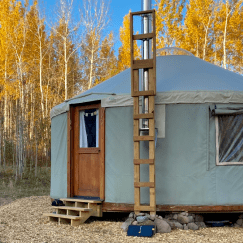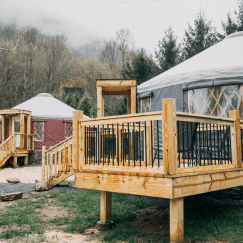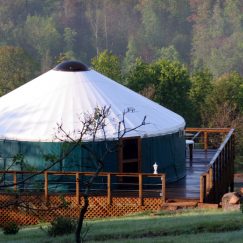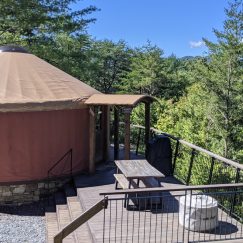Four Tips for Making a Sustainable Yurt Garden
Yurts have long been a go-to option for those interested in making their living situations more sustainable. Since yurts can be constructed at a relatively low cost, use little to no electricity, and often are located in serene and natural areas, they’ve become a popular (and efficient) way to live a greener life.
For most Pacific Yurt owners, gardening and maintaining the land around their yurt goes hand-in-hand with many of the energy-efficient practices encouraged by circular living. While cultivating the land around your yurt may be easier said than done–depending on your location–there are a few things to consider when it comes to developing a sustainable yurt garden. By practicing a handful of simple habits, you can successfully develop and maintain your garden with as little of a footprint as possible.
Check us out on Instagram for daily yurt inspiration!
 1. Think Creatively About Your Yurt Garden Space
1. Think Creatively About Your Yurt Garden Space
Congratulations! You’ve assembled your Pacific Yurt, and made it to the fun part: planting a yurt garden. The key elements to any garden are accessible water, sunlight, and the quality of the soil you’re using. When it comes to sustainability, you should also look for areas that receive more water naturally for conservation purposes. While this process can be time-consuming, it’s well worth the effort. Doing so will help you determine the perfect, and eco-friendly spot, for you to easily cultivate your land.
We recommend taking the time to observe the land around your yurt. Spend a few hours simply watching how the sun moves around it and look for daytime shadows that might obscure certain plots of land that hinder growth. Next, conduct a soil test in any area that seems the most viable for planting. Soil tests can be conducted by sending small samples to independent agricultural labs, which will tell you the composition of your dirt, and how well it will support a garden. Finally, consider how much moisture you’ll need for each area, and think carefully about the location of your beds and plots to maximize your water sustainably.
2. Harvest Rainwater and Use a Drip Irrigation System
One of the best things you can do when creating your sustainable Pacific Yurt garden is to harvest and reuse rainwater. You can do this by creating a basic DIY drip irrigation system that uses rainwater stored in a tank or cistern to deliver water to your plants through a hose in your garden. If you need to, attach a lid to the water collection barrel to ensure that animals (or children) aren’t able to contaminate the water inside. You’ll also want to place the spigot in a convenient location so it’s easily accessible.
Drip irrigation systems are a great way of directing water to where it needs to go. You can run a line from your tank to your plants, which can be covered in mulch or left exposed. When your rainwater tank is full, you can rely on gravity to distribute water to your plants accordingly. To maximize your resources, it’s important to place moisture-demanding plants closest to the waterline and move drought-resistant ones further away.
3. Segment and Choose Plants That Use Less Water
Another component of creating a sustainable garden around your Pacific Yurt is choosing eco-friendly plants that don’t over- consume water. Investing in more perennials and fewer annuals is an easy way to reduce water usage. If you’re looking to create a garden that provides the bulk of your produce, try selecting herbs and other edible plants that soak up less water, such as certain kinds of beans, squash, tomatoes, and melons.
consume water. Investing in more perennials and fewer annuals is an easy way to reduce water usage. If you’re looking to create a garden that provides the bulk of your produce, try selecting herbs and other edible plants that soak up less water, such as certain kinds of beans, squash, tomatoes, and melons.
Limit your growth of high-moisture plants like lettuce, corn, Brussel sprouts, and cabbage – or reuse rainwater when possible. If you have a few plants in your garden that need more moisture than others, try grouping them together, and leave drought-resistant, less water-hungry plants in a group of their own. Doing this will help you segment your water usage, which can make your garden more efficient overall.
4. Compost to Enrich Soil and Help Plants Grow
Another effective way to make your yurt garden greener is by composting your waste. Composting has become much more popular in recent years, and many of the common misconceptions about the process have been debunked. Knowing how to compost properly is key to your garden’s success. Generally, cold composting is very simple and safe. Add organic waste to your indoor compost bin to successfully create enough natural material to add to your garden and keep it healthy. Common things to compost include fruit and vegetable scraps, eggshells, and coffee grounds. Outside of the house, grass clippings, dry leaves, and straw make great composting materials as well. A great composting process is a critical step in making the garden outside of your Pacific Yurt as clean and sustainable as possible.
Start Growing Your Sustainable Yurt Garden Today!
Pacific Yurts has been the leader in yurt sustainability and industry practices since 1978. We champion green efforts by encouraging eco-friendly practices in and outside of our yurts.
Pin the full infographic
 1. Think Creatively About Your Yurt Garden Space
1. Think Creatively About Your Yurt Garden Space 



